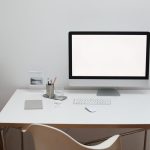Do you really need a monitor for your home office PC, or can you get by with just your laptop screen? Let's dive into the pros and cons to help you make an informed decision.
From boosting productivity to reducing eye strain, a monitor can revolutionize your work setup. We'll explore the benefits, compare different setups, and discuss cost-effective options.
Whether you're a seasoned pro or just starting to optimize your home office, understanding the role of a monitor is essential for creating a comfortable and efficient workspace.
Key Takeaways
- Using a monitor in your home office PC setup can improve focus, visual clarity, and work efficiency.
- A larger display and higher resolution monitor can provide more screen space for better multitasking.
- It is important to consider ergonomics and take steps to prevent eye strain, such as using adjustable monitor stands and anti-glare screens.
- While laptops offer portability and space-saving benefits, desktops with larger screens and the option for dual monitors provide more power and customization for a comfortable and efficient home office setup.
Benefits of Using a Monitor
You'll appreciate the clarity and comfort a monitor provides when working long hours at your home office PC. The improved focus and visual clarity offered by a monitor can significantly enhance your work experience. Unlike a laptop screen, a monitor's larger display and higher resolution allow you to see more details and minimize eye strain. This visual enhancement can lead to increased work efficiency as you can work more effectively and with greater precision.
Additionally, using a monitor can also promote better posture. With a larger screen, you can adjust the height and angle to ensure that it's at eye level, reducing the strain on your neck and back. This ergonomic advantage not only contributes to your physical well-being but also supports your overall productivity. By maintaining a comfortable and upright position, you're better able to focus on your tasks without the distraction of discomfort.
Productivity and Comfort Considerations
When considering whether you need a monitor for your home office PC, it's important to think about ergonomics and eye strain. A larger screen can provide more comfort and reduce the risk of strain during long work hours.
Additionally, having more screen space allows for better multitasking, which can ultimately increase your productivity.
Ergonomics and Eye Strain
To prevent eye strain and enhance productivity, adjust your monitor's position to be at eye level with a comfortable viewing distance. Maintaining an ergonomic setup is crucial for your eye health and overall well-being.
Here are three essential considerations for optimizing your workspace:
- Blue light exposure: Invest in a monitor with a blue light filter or wear blue light blocking glasses to reduce eye strain caused by prolonged screen time.
- Posture correction: Ensure your monitor is positioned at arm's length away, with the top of the screen at or slightly below eye level. This helps in maintaining a proper sitting posture and reduces strain on your neck and back.
- Regular breaks: Implement the 20-20-20 rule, where every 20 minutes, look at something 20 feet away for at least 20 seconds to give your eyes a break.
Multitasking and Screen Space
How efficiently can you manage multiple tasks on a single screen while maintaining comfort and productivity in your home office setup?
Effective screen organization is key to maximizing multitasking capabilities. Consider using window snapping or virtual desktops to organize different tasks, allowing you to switch between them seamlessly.
Task management tools and software can further enhance your ability to handle multiple responsibilities simultaneously.
When it comes to screen space, a larger monitor or multiple monitors can provide the real estate needed for comfortable multitasking. With the right setup, you can position your windows for optimal visibility, reducing the need for constant resizing and minimizing eye strain.
Prioritizing screen space and efficient task management can significantly boost your productivity and comfort in your home office.
Comparison With Laptop and All-In-One Desktops
You can connect your home office PC to a laptop or all-in-one desktop for a dual-screen setup, enhancing your productivity and multitasking capabilities.
When comparing these setups, consider the following:
- Laptop vs Desktop: Laptops offer portability and space-saving benefits, making them ideal for those who require flexibility and have limited space. However, desktops often provide more power, upgradability, and larger screen options, which can be advantageous for demanding tasks and extended usage.
- All-in-One vs Monitor Only: All-in-one desktops integrate the computer components into the monitor, resulting in a sleek and compact design. They're convenient for those prioritizing aesthetics and simplicity. On the other hand, using a separate monitor with a traditional desktop allows for more customization in terms of screen size, resolution, and the ability to mix and match components according to specific needs.
- Ergonomics and Comfort: When considering a dual-screen setup, it's essential to factor in ergonomics and comfort. Both laptops and all-in-one desktops have built-in screens, which may limit the adjustability for optimal viewing angles and posture. Using a separate monitor with a desktop PC allows for more flexibility in setting up an ergonomic workspace tailored to individual preferences.
When making your decision, weigh the factors of portability, power, aesthetics, and ergonomics to determine the best setup for your home office.
Ergonomics and Eye Strain Prevention
Continuing from the comparison of different setups, consider the ergonomics and eye strain prevention when deciding on the best display option for your home office PC. Ensuring proper eye health and creating a comfortable workspace setup is crucial for maintaining productivity and preventing long-term strain on your eyes.
| Ergonomic Accessories | Blue Light Filters |
|---|---|
| Adjustable monitor stands | Blue light filter glasses |
| Ergonomic keyboard and mouse | Blue light filter screen protectors |
| Anti-glare monitor screens | Blue light filter software |
| Standing desks | Blue light filter monitor settings |
| Monitor arms for flexible positioning | Blue light filter apps for smartphones |
When setting up your home office, investing in ergonomic accessories such as adjustable monitor stands, ergonomic keyboards and mice, and anti-glare monitor screens can significantly reduce strain on your eyes, neck, and back. Additionally, incorporating blue light filters, whether through specialized glasses, screen protectors, software, or monitor settings, can help minimize the impact of blue light emitted by digital screens, which is known to contribute to eye strain and disrupt sleep patterns. Prioritizing ergonomics and eye strain prevention in your home office setup can lead to improved comfort and long-term eye health.
Multi-Tasking and Screen Real Estate
You'll be able to juggle multiple tasks more effectively with a larger screen, increasing your productivity.
Utilizing screen real estate efficiently allows for better organization of your workflow, making it easier to access and reference important documents and applications.
With more space, you can arrange your work tools in a way that suits your work style, leading to a more streamlined and productive home office setup.
Increased Productivity With Multitasking
To maximize your productivity while working from home, having multiple screens can significantly enhance your multitasking capabilities. This increased screen real estate allows for improved efficiency and increased focus. Here's how it can help you achieve mastery in your home office setup:
- Enhanced Task Management: With multiple screens, you can easily view and work on different tasks simultaneously, minimizing the need to switch between windows and applications.
- Seamless Information Processing: You can have reference materials, communication tools, and work documents open and visible at the same time, leading to smoother information processing.
- Streamlined Workflow: By organizing your workspace across multiple screens, you can create a more efficient workflow, reducing the time spent searching for and transitioning between various resources.
Investing in multiple screens can undoubtedly elevate your multitasking abilities, ultimately leading to increased productivity and mastery in your home office environment.
Efficient Use of Space
With multiple screens, you can efficiently utilize your workspace, maximizing your multitasking capabilities and screen real estate for improved productivity in your home office.
Space efficiency is crucial for desk organization, allowing you to have all the necessary tools and documents within easy reach.
By using multiple monitors, you can view different applications simultaneously, reducing the need to constantly switch between tabs or windows. This enhances your ability to work on multiple tasks at once, resulting in better time management and increased productivity.
Additionally, you can arrange your screens to fit your workflow, whether it's comparing documents side by side or having a dedicated screen for communication tools.
This level of customization optimizes your screen real estate and helps you maintain a clear and organized desk space for efficient work.
Enhanced Workflow Organization
Maximize your multitasking capabilities and screen real estate by utilizing multiple monitors for enhanced workflow organization in your home office. This setup allows for seamless navigation between various tasks, significantly boosting your workflow efficiency.
Here's how multiple monitors can revolutionize your workspace organization:
- Task Segmentation: Allocate each monitor to a specific task or application, promoting focused attention and reducing the clutter on your primary screen.
- Enhanced Multitasking: Effortlessly work on multiple projects simultaneously, increasing productivity and reducing the need to constantly switch between windows.
- Expanded Screen Real Estate: Spread out your work across multiple screens, providing a more comprehensive view of your projects and facilitating smoother transitions between tasks.
Cost-Effective Monitor Options
You can save money and enhance productivity by choosing a monitor with the right features for your home office PC. When considering cost-effective options, monitor size is a crucial factor to weigh. A larger monitor provides more screen real estate, allowing for better multitasking and increased workflow efficiency. However, larger monitors tend to be pricier. To strike a balance between cost and functionality, consider a monitor size between 24 to 27 inches. This range offers ample space for various applications without breaking the bank.
Another cost-effective option to consider is the resolution of the monitor. While 4K resolution monitors offer stunning clarity, they come with a higher price tag. Opting for a 1080p or 1440p resolution monitor can provide a good balance between visual quality and cost.
Furthermore, look for monitors with adjustable stands that offer tilt, swivel, and height adjustments. This versatility allows for ergonomic customization, reducing strain during long work hours. Additionally, consider monitors with built-in speakers to save on the cost of external speakers.
Frequently Asked Questions
Can I Use a TV as a Monitor for My Home Office Pc?
Yes, you can use a TV as a monitor for your home office PC. It's a cost-effective alternative, but be mindful of resolution and refresh rate. Virtual reality monitor alternatives are available for immersive experiences.
What Are the Best Monitor Options for Reducing Eye Strain and Promoting Good Ergonomics?
To reduce eye strain and promote good ergonomics, consider monitors with blue light filters and adjustable stands. Ultra-wide, curved screens can also enhance your viewing experience. These options are great for reducing strain and enhancing comfort.
Are There Any Specific Features I Should Look for in a Monitor to Enhance Multi-Tasking and Screen Real Estate?
When choosing a monitor for your home office PC, look for features that enhance multitasking and screen real estate. Consider a larger screen, higher resolution, and multiple display ports to boost your productivity.
How Do I Set up a Dual Monitor System for My Home Office Pc?
To set up a dual monitor system for your home office PC, start by connecting the monitors with appropriate cables, adjusting the screen resolution in the display settings, and exploring connectivity options for efficient cable management.
Are There Any Alternatives to Using a Traditional Monitor for My Home Office Setup, Such as a Projector or Virtual Reality Headset?
Yes, you can consider a projector alternative for a larger display and a virtual reality headset option for immersive work. Both offer unique benefits and can be effective alternatives to a traditional monitor for your home office setup.




